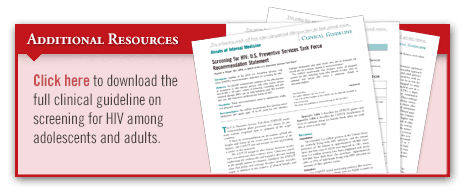In the United States, an estimated 1.2 million people are infected with HIV, and about 50,000 new cases emerge each year. Since the first cases of AIDS were reported in 1981, more than 1.1 million people have been diagnosed with the disease, and nearly 595,000 deaths have been attributed to it. About 20% to 25% of individuals living with HIV are unaware that they are infected with the virus.
According to the U.S. Preventive Services Task Force (USPSTF), there is convincing evidence to suggest that identifying and treating HIV infection can markedly reduce the risk for HIV to progress to AIDS, AIDS-related events, and death in people who have immunologically advanced disease. Clinical data also show that initiating antiretroviral therapy (ART) earlier in patients with HIV—when they are most likely to be asymptomatic and detected by screening rather than clinical presentation—can decrease risks for AIDS-related events or death and transmission of HIV to uninfected people.
Updated Recommendations
In 2013, the USPSTF updated its 2005 recommendation statement on screening for HIV for adolescents, adults, and pregnant women. The USPSTF reviewed new evidence on the effectiveness of treatments for HIV in people with CD4 counts exceeding 0.200 × 109 cells/L. It also reviewed data on the effects of screening, counseling, and ART use on risky behaviors and HIV transmission risk as well as the long-term cardiovascular harms of ART. “The new USPSTF HIV screening guidelines now align more closely with recommendations that were released by the CDC back in 2006,” adds Dr. Volberding.
According to the USPSTF recommendations, which were published in the Annals of Internal Medicine, all adults and adolescents aged 15 to 65 should be screened for HIV. Younger adolescents and older adults at increased risk for HIV should be screened for the infection as well as all pregnant women, including those who present in labor with unknown HIV status and no previous testing. Women screened during pregnancy should be rescreened in subsequent pregnancies.
The USPSTF identified several factors that should be considered when assessing patients’ risk of HIV infection (Table 1). It has been speculated that targeted screening can miss a substantial number of HIV-infected patients because of potentially undisclosed or unknown risk factors. Dr. Volberding says that more vigilant screening of HIV is needed for all individuals. “Testing should be directed across large patient populations,” he says, “but it’s especially important to pay attention to those at higher risk.”
Currently available evidence is insufficient to determine the optimum time intervals for HIV screening. The USPSTF notes that a reasonable approach would be to provide a one-time screening to find those who are HIV positive and rescreening those found to be HIV negative who remain engaged in high-risk behaviors.
Tests & Interventions
Several screenings and interventions are recom-mended by the USPSTF (Table 2). Rapid screening tests that use blood or oral fluid specimens have been shown to be as accurate as conventional tests, which include using repeatedly reactive immunoassays of serum specimens followed by confirmatory Western blot or immunofluorescent assays. However, clinicians should confirm positive rapid screening test results with conventional testing.
“When the USPSTF screening guidelines were last revised, the committee was concerned that HIV testing might lead to psychological harm and that treatment might have serious side effects,” Dr. Volberding says. “There is now evidence showing that HIV screening is associated with little risk for harm and with better clinical outcomes when compared with no screening. Furthermore, starting ART in asymptomatic people identified by HIV screening may lead to better outcomes.”
Although ART drugs, drug classes, and combinations are associated with short-term adverse events, many of these issues are transient and oftentimes can be managed with effective alternatives. Some medications have been linked to higher risks for cardiovascular events and other problems, but the magnitude of this risk appears to be small. Overall, the potential harms of screening for and treating HIV infection outweigh the risks.
Looking Forward
Current treatments have made HIV infection a chronic disease by prolonging survival and preventing further transmission. According to Dr. Volberding, the overall benefits of screening for HIV infection are substantial. “By informing all infected people of their HIV status, we can potentially decrease ongoing transmission-risk behaviors and increase earlier use of ART to further reduce the spread of infection. With an increasing effort toward more vigilant screening, growing confidence in available treatments, and the goal of universal access to care, we may finally get closer to ending the HIV/AIDS epidemic.”




 admin
admin